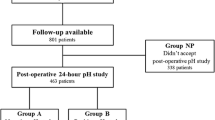Abstract
Gastroesophageal reflux (GER) can develop in patients with esophageal achalasia either before treatment or following pneumatic dilatation or Heller myotomy. In this study we assessed the value of pre- and postoperative pH monitoring in identifying GER in patients with esophageal achalasia. Ambulatory pH monitoring was performed preoperatively in 40 patients with achalasia (18 untreated patients and 22 patients after pneumatic dilatation), 27 (68%) of whom complained of heartburn in addition to dysphagia (group A), and postoperatively in 18 of 51 patients who underwent a thoracoscopic (n=30) or laparoscopic (n=21) Heller myotomy (group B). The DeMeester reflux score was abnormal in 14 patients in group A, 13 of whom had been treated previously by pneumatic dilatation. Two types of pH tracings were seen: (1) GER in eight patients (7 of whom had undergone dilatation) and (2) pseudo-GER in six patients (all 6 of whom had undergone dilatation). Therefore 7 (32%) of 22 patients had abnormal GER after pneumatic dilatation. Postoperatively (group B) seven patients had abnormal GER (6 after thoracoscopic and 1 after laparoscopic myotomy). Six of the seven patients were asymptomatic. These findings show that (1) approximately one third of patients treated by pneumatic dilatation had GER; (2) symptoms were an unreliable index of the presence of abnormal GER, so pH monitoring must be performed in order to make this diagnosis; and (3) the preoperative detection of GER in patients with achalasia is important because it influences the choice of operation.
Similar content being viewed by others
References
Spechler SJ, Souza RF, Rosenberg SJ, Ruben RA, Goyal RK. Hearburn in patients with achalasia. Gut 1995;37:305–308.
Shoenut JP, Micflikier AB, Yaffe CS, Den Boer B, Teskey JM. Reflux in untreated achalasia patients. J Clin Gastroenterol 1995;20:6–11.
Smart HL, Foster PN, Evans DF, Slevin B, Atkinson M. Twenty-four hour oesophageal acidity in achalasia before and after pneumtic dilatation. Gut 1987;28:883–887.
Crookes PF, Corkill S, DeMeester TR. When is “reflux” in achalasia realyy reflux? [abstr]. Gastroenterology 1994;106:65.
Vantrappen G, Hellemans J. Treatment of achalasia and related motor disorders. Gastroenterology 1980;79:144–154.
Sauer L, Pellegrini CA, Way LW. The treatment of achalasia. Arch Surg 1989;124:929–932.
Okike N, Payne WS, Neufeld DM, Bernatz PE, Pairolero PC, Sanderson DR. Esophagomyotomy versus forceful dilation for achalasia of the esophagus: Results in 899 patients. Ann Thorac Surg 1979;28:119–125.
Ferguson MK. Achalasia: Current evaluation and therapy. Ann Thorac Surg 1991;52:336–342.
Ellis FH, Gibb SP, Crozier RE. Esophagomyotomy for achalasia of the esophagus. Ann Surg 1980;192:157–161.
Bonavina L, Nosadini A, Bardini R, Baessato M, Peracchia A. Primary treatment of esophageal achalasia. Arch Surg 1992;127:222–227
Pellegrini C, Wetter LA, Patti M, Leichter R, Mussan G, Mori T, Bernstein G, Way L. Thoracoscopic esophagomyotomy. Initial experience with a new approach for the treatment of achalasia. Ann Surg 1992;216:291–299.
Wehrmann T, Jacobi V, Jung M, Lembcke B, Caspary WF. Pneumatic dilatation in achalasia with a low-compliance balloon: Results of a 5-year prospective evaluation. Gastrointest Endosc 1995;42:31–36.
Patti MG, Debas HT, Pellegrini CA. Clinical and functional characterization of high gastroesophageal reflux. Am J Surg 1993;165:163–168.
Jamieson JR, Stein HJ, DeMeester TR, Bonavina L, Schwizer W, Hinder RA, Albertucci M. Ambulatory 24-hour esophageal pH monitoring: Normal values, optimal thresh-olds, specificity, sensitivity, and reproducbility. Am J Gastroenterol 1992;87:1102–1111.
Patti MG, Pellegrini CA, Arcerito M, Tong J, Mulvihill SJ, Way LW. Comparison of medical and minimally invasive surgical therapy for primary esophageal motility disorders. Arch Surg 1995:130:609–616.
Rosati R, Fumagalli U, Bonavina L, Segalin A, Monotorsi M, Bona S, Peracchia A. Laparoscopic approach to esophageal achalasia. Am J Surg 1995;169:424–427.
Patti MG, Bortolasi L, Arcerito M, Tong J, Murgia AP, Way LW. Clinical and radiographic findings are unreliable to diagnose gastroesophageal reflux disease [abstr]. Gastroenterology 1995;108:1238.
Costantini M, Crookes PF, Bremner RM, Hoeft SF, Ehsan A, Peters JH, Bremner CG, DeMeester TR. Value of physiologic assessment of foregut symptoms in a surgical practice. Surgery 1993;114:780–787.
Fuchs KH, DeMeester TR, Albertucci M. Specificity and sensitivity of objective diagnosis of gastroesophageal reflux disease. Surgery 1987;102:575–580.
Ellis FH Jr. Oesophagomyotomy for achalasia: A 22-year experience. Br J Surg 1993;80:882–885.
Jaakkola A, Reinikainen P, Ovaska J, Isolauri J. Barrett’s esophagus after cardiomyotomy for esophageal achalasia. Am J Gastroenterol 1994;89:165–169.
Jaakkola A, Ovaska J, Isolauri J. Esophagocardiomyotomy for achalasia. Eur J Surg 1991;157:407–410.
Parrilla Paricio P, Martinez de Haro L, Ortiz A, Aguayo JL. Achalasia of the cardia: Long-term results of esophagomyotomy and posterior partial fundoplication. Br J Surg 1990;77:1371–1374.
Streitz JM, Ellis FH Jr, Williamson WA, Glick ME, Aas JA, Tilden RL. Objective assessment of gastroesophageal reflux after short esophagomyotomy for achalasia with the use of manometry and pH monitoring. J Thorac Cardiovasc Surg 1996;11:107–113.
Swanstrom LL, Pennings J. Laparoscopic esophagomyotomy for achalasia. Surg Endosc 1995;9:286–292.
Mitchell PC, Watson DI, Devitt PG, Britten-Jones R, Mac-Donald S, Myers JC, Jamieson GG. Laparoscopic cardiomyotomy with a Dor patch for achalasia. Can J Surg 1995;38: 445–448.
Ancona E, Anselmino M, Zaninotto G, Costantini M, Rossi M, Bonavina L, Boccu C, Buin F, Peracchia A. Esophageal achalasia: Laparoscopic versus conventional open Heller-Dor operation. Am J Surg 1995;170:265–270.
Author information
Authors and Affiliations
Rights and permissions
About this article
Cite this article
Patti, M.G., Arcerito, M., Tong, J. et al. Importance of preoperative and postoperative pH monitoring in patients with esophageal achalasia. J Gastrointest Surg 1, 505–510 (1997). https://doi.org/10.1016/S1091-255X(97)80065-0
Issue Date:
DOI: https://doi.org/10.1016/S1091-255X(97)80065-0




